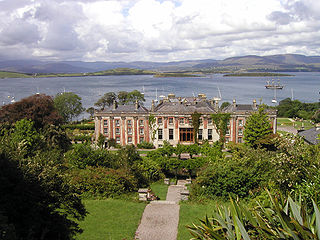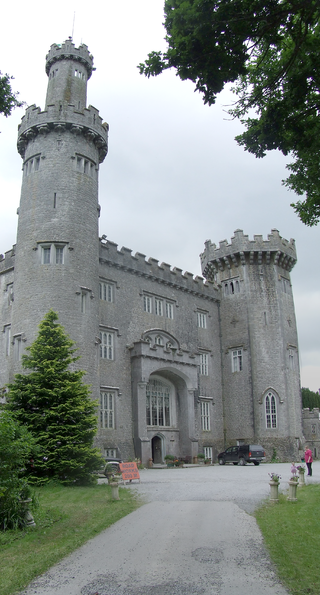
Marquess of Londonderry, of the County of Londonderry, is a title in the Peerage of Ireland.

Earl of Kingston is a title in the Peerage of Ireland. It was created in 1768 for Edward King, 1st Viscount Kingston. The Earl holds the subsidiary titles Baron Kingston, of Rockingham in the County of Roscommon, Viscount Kingston, of Kingsborough in the County of Sligo, Baron Erris, of Boyle in the County of Roscommon, and Viscount Lorton, of Boyle in the County of Roscommon, also in the Peerage of Ireland. He is also a baronet in the Baronetage of Ireland. Between 1821 and 1869 the earls also held the title Baron Kingston, of Mitchelstown in the County of Cork, in the Peerage of the United Kingdom.

Earl Erne, of Crom Castle in the County of Fermanagh, is a title in the Peerage of Ireland. It was created in 1789 for John Creighton, 2nd Baron Erne, who had earlier represented Lifford in the Irish House of Commons. He had already been made Viscount Erne, of Crom Castle in the County of Fermanagh, in 1781, also in the Peerage of Ireland, and sat from 1800 to 1828 as an Irish representative peer in the British House of Lords. The title of Baron Erne, of Crom Castle in the County of Fermanagh, was created in the Peerage of Ireland in 1768 for his father Abraham Creighton. The Earl was succeeded by his eldest son, the second Earl. On his death the titles passed to his nephew, the third Earl. He was an Irish Representative Peer from 1845 to 1885 and also served as Lord Lieutenant of County Fermanagh during the same period. In 1876 he was created Baron Fermanagh, of Lisnaskea in the County of Fermanagh, in the Peerage of the United Kingdom. This was to allow the Earls to sit in the House of Lords by right, rather than having to stand for election as Representative Peers. An earlier title of Baroness Fermanagh in the Peerage of Ireland was created for Mary Verney on 13 June 1792, but became extinct on her death on 15 November 1810.

Earl of Donoughmore is a title in the Peerage of Ireland. It is associated with the Hely-Hutchinson family. Paternally of Gaelic Irish descent with the original name of Ó hÉalaighthe, their ancestors had long lived in the County Cork area as allies of the Mac Cárthaigh clan; they lost out during the times of Oliver Cromwell. One branch of the family converted to the Anglican Church and after inheriting territories through his mother and adding "Hutchinson" to Hely, became the Earl of Donoughmore.

Viscount Hawarden is a title in the Peerage of Ireland.

Baron Inchiquin is one of the older titles in the Peerage of Ireland. It was one of two titles created on 1 July 1543 for Murrough O'Brien, Prince of Thomond, who claimed descent from Brian Boru, a High King of Ireland. The grant of the English titles was conditional upon the abandonment of any Irish titles, the adoption of English customs and laws, pledging of allegiance to the Crown, apostasy from the Catholic Church, and conversion to the Church of Ireland. Murrough was made both Earl of Thomond in the Peerage of Ireland, with remainder to his nephew Donough O'Brien and Baron Inchiquin, with remainder to his male heirs. Following the death of his cousin, Conor Myles John O' Brien in June 2023, Conor John Anthony O' Brien is currently the 19th Baron Inchiquin

Baron Farnham, of Farnham in the County of Cavan, is a title in the Peerage of Ireland. It was created in 1756 for John Maxwell, who had previously represented Cavan Borough in the Irish House of Commons. John Maxwell's son, the second Baron, was created Viscount Farnham in 1760 and Earl of Farnham in 1763. Both titles were in the Peerage of Ireland but became extinct when he died childless in 1779. His brother and successor, the third Baron, was again created Viscount Farnham in 1781 and Earl of Farnham in 1785. These titles were also in the Peerage of Ireland. His son, the second Earl, sat in the House of Lords as an Irish representative peer from 1816 to 1823. However, he had no children and on his death in 1823 the viscountcy and earldom became extinct.

Baron Langford, of Summerhill in the County of Meath, is a title in the Peerage of Ireland. It was created on 1 July 1800 for Clotworthy Rowley, who had earlier represented Trim and County Meath in the Irish House of Commons. Born Clotworthy Taylor, he was the fourth son of Thomas Taylor, 1st Earl of Bective and Jane Rowley, daughter of Hercules Langford Rowley and his wife Elizabeth Rowley, 1st Viscountess Langford. The viscountcy of Langford became extinct in 1796 on the death of Hercules Rowley, 2nd Viscount Langford. Clotworthy Taylor succeeded to the Rowley estates and assumed by Royal licence the surname of Rowley in lieu of Taylor. Four years later the Langford title was revived when he was raised to the Peerage of Ireland as Baron Langford.
Baron de Freyne, of Coolavin in the County of Sligo, is a title in the Peerage of the United Kingdom. It was created in 1851 for Arthur French, 1st Baron de Freyne, with remainder to his younger brothers John, Charles and Fitzstephen French. He had earlier represented County Roscommon in the House of Commons and later served as Lord Lieutenant of County Roscommon. French had already been created Baron de Freyne, of Artagh in the County of Roscommon, in 1839, also in the Peerage of the United Kingdom but with normal remainder to heirs male. Lord de Freyne was childless and on his death in 1856 the barony of 1839 creation became extinct. The barony of 1851 creation survives according to the special remainder by his younger brother John, the second Baron.

Earl of Bantry, of Bantry in the County of Cork, was a title in the Peerage of Ireland. It was created in 1816 for Richard White, 1st Viscount Bantry, who had helped repelling the French invasion at Bantry Bay in 1797. He had already been created Baron Bantry, of Bantry in the County of Cork, and Viscount Bantry, of Bantry in the County of Cork, in 1800, and was made Viscount Berehaven at the same time he was given the earldom. These titles were also in the Peerage of Ireland. He was the grandson of Richard White, who had made an immense fortune through his work as a lawyer. Lord Bantry was succeeded by his son, the second Earl. He sat on the Conservative benches in the House of Lords as an Irish representative peer from 1854 to 1868. His younger brother, the third Earl, assumed in 1840 by Royal licence the additional surname of Hedges, which was that of his paternal grandmother. He was an Irish Representative Peer from 1869 to 1884. The titles became extinct on the death of his son, the fourth Earl, in 1891.
This is a list of people who have served as Lord Lieutenant of County Tipperary between 1831 and 1922.

Henry Prittie, 1st Baron Dunalley was an Irish peer and Member of Parliament.

Henry Prittie, 2nd Baron Dunalley was an Anglo-Irish politician.

Henry O'Callaghan Prittie, 4th Baron Dunalley, was an Anglo-Irish peer.
Events from the year 1851 in Ireland.

Charles William Bury, 1st Earl of Charleville FRS, FSA, known as The Lord Tullamore between 1797 and 1800 and as The Viscount Charleville between 1800 and 1806, was an Irish landowner, antiquarian and politician.
Francis Aldborough Prittie was an Irish Member of Parliament in the Parliament of the United Kingdom.
Cornelius O'Callaghan, 1st Baron Lismore, was an Irish politician and peer.
Cornelius O'Callaghan, 1st Viscount Lismore PC (I) was an Irish Whig politician.













